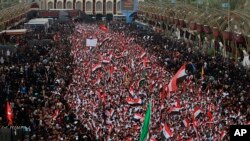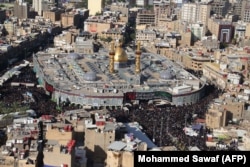Since 2013, the Islamic Republic of Iran has been spending an unusual amount of time, money, energy and manpower on a hitherto low-key religious ritual: Arbaeen. The Occasion marks the anniversary of the 40th day after the martyrdom of Imam Hussain, the third Shiite Imam in Iraq in the year 680 AD in Karbala, Iraq. Iran's investment turned the relatively silent ritual in comparison to Ashura which mark's the anniversary Imam's martyrdom day, into a big march across Iraq with many Iranians taking part.
In spite of the official figures for the turnout in the event in Iraq this year, the actual figures could have been different as Iranians find it increasingly more difficult to provide the hard currency for a trip to Iraq, and the Iraqi government's reluctance to admit hundreds of thousands of visitors while the country was in a political turmoil as tens of thousands of angry Iraqis took to the streets to protest corruption, unemployment and discrimination. Radio Farda's Iran Analyst Reza Haqiqatnejad probes into the way Iran has been exploiting the religious ritual in the neighboring country.
As the Arbaeen procession ended on October 19, President Hassan Rouhani claimed "the number of Iranian pilgrims in 2019 was 14 times bigger than previous governments," and called this an "achievement" for his administration.
This is not true. The government did not pay any particular attention to this ritual until 2013. In 2012 around 500 thousand Iranian pilgrims took part in the event. This year the government claimed the number has risen to 3.5 million which makes it 7 times bigger than when President Mahmoud Ahmadinejad was Iran's President.
Iranian officials have said at times that the "Arbaeen procession is the biggest gathering in the world in the past and present," and have estimated their numbers to be in "millions."
The figures are so important for the Iranian government that IRGC-linked Fars news agency claimed over 1.5 million Iranians twitted about Arbaeen in only one night. The figure was of course false.
Mohammad Javad Haj Ali Akbari who heads the organization that holds Friday Prayers in Iran said on October 18 that all together 30 million people have taken part in the ritual. The next day, Tasnim news agency put the number at 21 million and later at 15 million including 11 million Iraqis.
Although Interior Minister Abdolreza Rahmani Fazli has claimed that the government does not subsidize the pilgrimage, there are several reports indicating that the government t has spent 1.25 trillion rials (around $30 million) on the "infrastructure" for Arbaeen pilgrimage apart from sending free medicine, food and water.
Only the administration of the holy shrine in Mashad announced it has distributed 750,000 portions of food among the pilgrims in Iraq every day for two weeks. Other public service providers such as Iranian Municipalities also spend a lot of money on the ritual.
For example, the Tehran Municipality allocated 100 billion rials ($2.4 million), Shiraz municipality spent 10 billion rials and other municipalities in Western Iran have spent 1,370 billion rials on the pilgrimage. The IRGC has said it has dispatched 170,000 individuals to Iraq to help the pilgrims but did not say how much it has spent.
In all, Iran makes a huge investment in terms of transport, catering, accommodation and security of the pilgrims in what it thinks is a show of Iran's power in Iraq.
A month before Arbaeen Supreme Leader Ali Khamenei called for even more widespread and "powerful" presence in Iraq as he believes this is a way of bringing about a "new Islamic civilization."
Khamenei obviously considers the Arbaeen procession as a competition with regional powers particularly Saudi Arabia, Iran's grand rival in the region, which controls the annual Haj pilgrimage with around 2 million pilgrims.
Using a religious event such as Arbaeen as an instrument to further the policies of the Supreme Leader of the Islamic Republic is neither strange, nor unprecedented. It explains how the Islamic Republic spends hefty sums to turn the religious ritual into political propaganda. It also serves another purpose: Pleasing the Supreme Leader.








